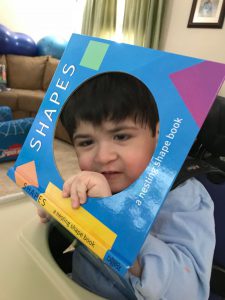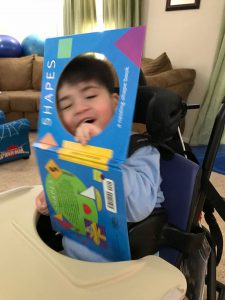 I opened the cover of the shape book, held it up to my face, and gave Joey a quick smile through the cut out circle in the cover of the book. I’m not sure why I did it, but in the moment it had seemed like a silly interaction between reading different books. Not thinking anymore about it, I placed the book on his tray and turned around to get something else. When I turned back to Joey, he was holding the book up and grinning at me through the hole, with his eyes sparkling playfully. He quickly lost his grip on the awkward book, but he worked to turn the book from side to side and try to get his head back through the hole in the cover. He giggled and laughed throughout this experience, proud of himself for copying my joke, for surprising me, and for managing to get the book up in front of his face so many times.
I opened the cover of the shape book, held it up to my face, and gave Joey a quick smile through the cut out circle in the cover of the book. I’m not sure why I did it, but in the moment it had seemed like a silly interaction between reading different books. Not thinking anymore about it, I placed the book on his tray and turned around to get something else. When I turned back to Joey, he was holding the book up and grinning at me through the hole, with his eyes sparkling playfully. He quickly lost his grip on the awkward book, but he worked to turn the book from side to side and try to get his head back through the hole in the cover. He giggled and laughed throughout this experience, proud of himself for copying my joke, for surprising me, and for managing to get the book up in front of his face so many times.
In that moment, that was Joey’s play. Just a hole in a book cover, and the two of us, laughing as we peeked at each other back and forth through the hole. It wasn’t complex, it did not involve a toy or a game, and I certainly had not planned for it. Yet it involved all of Brown’s play properties mentioned last week. The interaction was apparently purposeless (or done for its own sake), voluntary (I hadn’t told Joey to do it), held an inherent attraction for Joey, provided a sense of a freedom from time and diminished consciousness of self, contained improvisational potential, and a continuation desire (Brown, 2009).
So are moments of play that important?
The Polyagal theory’s definition of play defines play as a neural exercise that helps us promote neural pathways that support our mental and physical health. Play, and moments of silly giggles, helps us map our brain. The more engaged we are in one another and ourselves in a playful way, the more regions of our brain become involved, the more neural pathways are mapped, and the more we organize ourselves. Play is a neurological exercise that grows the brain.

Harvard’s Center for the Developing Child department has excellent web resources on how the brain responds to back and forth reciprocal play. It’s important to remember that this development does not end when babies become toddlers, or when toddlers become preschoolers, but it continues throughout our lives. For children with cognitive, motor, or developmental impairments, guided play and increased opportunities for serve and return are excellent ways to help a child through the developmental stages.
Perhaps one of the infuriating pieces of play is that it cannot be planned for. It seems like I should be able to bring toys with me to Joey’s house and set up a play scheme for the two of us. And yet, then it wouldn’t be a playful exercise for Joey in a true definition of play. I can bring whatever I think can help establish a playful routine, but genuine, meaningful play will only be achieved if I follow his lead and follow what makes him laugh – like peeking through the hole in a book cover.


